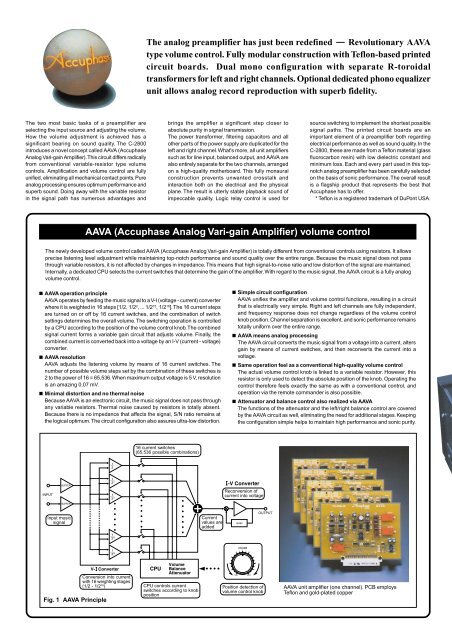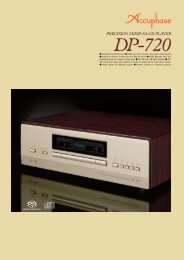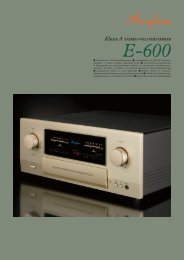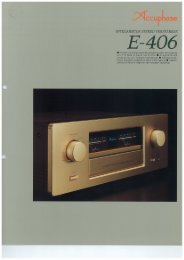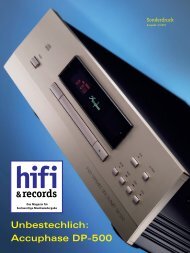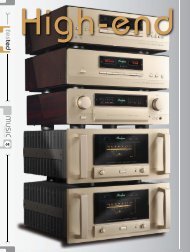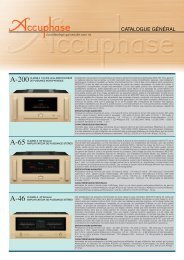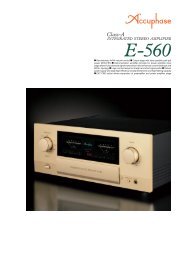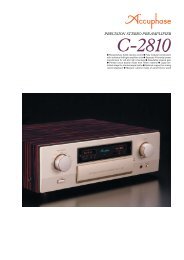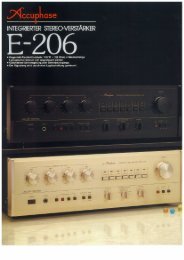m Revolutionary AAVA volume control m Printed circuit ... - Accuphase
m Revolutionary AAVA volume control m Printed circuit ... - Accuphase
m Revolutionary AAVA volume control m Printed circuit ... - Accuphase
Create successful ePaper yourself
Turn your PDF publications into a flip-book with our unique Google optimized e-Paper software.
The two most basic tasks of a preamplifier are<br />
selecting the input source and adjusting the <strong>volume</strong>.<br />
How the <strong>volume</strong> adjustment is achieved has a<br />
significant bearing on sound quality. The C-2800<br />
introduces a novel concept called <strong>AAVA</strong> (<strong>Accuphase</strong><br />
Analog Vari-gain Amplifier). This <strong>circuit</strong> differs radically<br />
from conventional variable-resistor type <strong>volume</strong><br />
<strong>control</strong>s. Amplification and <strong>volume</strong> <strong>control</strong> are fully<br />
unified, eliminating all mechanical contact points. Pure<br />
analog processing ensures optimum performance and<br />
superb sound. Doing away with the variable resistor<br />
in the signal path has numerous advantages and<br />
The analog preamplifier has just been redefined <strong>Revolutionary</strong> <strong>AAVA</strong><br />
type <strong>volume</strong> <strong>control</strong>. Fully modular construction with Teflon-based printed<br />
<strong>circuit</strong> boards. Dual mono configuration with separate R-toroidal<br />
transformers for left and right channels. Optional dedicated phono equalizer<br />
unit allows analog record reproduction with superb fidelity.<br />
brings the amplifier a significant step closer to<br />
absolute purity in signal transmission.<br />
The power transformer, filtering capacitors and all<br />
other parts of the power supply are duplicated for the<br />
left and right channel. What's more, all unit amplifiers<br />
such as for line input, balanced output, and <strong>AAVA</strong> are<br />
also entirely separate for the two channels, arranged<br />
on a high-quality motherboard. This fully monaural<br />
construction prevents unwanted crosstalk and<br />
interaction both on the electrical and the physical<br />
plane. The result is utterly stable playback sound of<br />
impeccable quality. Logic relay <strong>control</strong> is used for<br />
<strong>AAVA</strong> (<strong>Accuphase</strong> Analog Vari-gain Amplifier) <strong>volume</strong> <strong>control</strong><br />
source switching to implement the shortest possible<br />
signal paths. The printed <strong>circuit</strong> boards are an<br />
important element of a preamplifier both regarding<br />
electrical performance as well as sound quality. In the<br />
C-2800, these are made from a Teflon material (glass<br />
fluorocarbon resin) with low dielectric constant and<br />
minimum loss. Each and every part used in this topnotch<br />
analog preamplifier has been carefully selected<br />
on the basis of sonic performance. The overall result<br />
is a flagship product that represents the best that<br />
<strong>Accuphase</strong> has to offer.<br />
* Teflon is a registered trademark of DuPont USA.<br />
The newly developed <strong>volume</strong> <strong>control</strong> called <strong>AAVA</strong> (<strong>Accuphase</strong> Analog Vari-gain Amplifier) is totally different from conventional <strong>control</strong>s using resistors. It allows<br />
precise listening level adjustment while maintaining top-notch performance and sound quality over the entire range. Because the music signal does not pass<br />
through variable resistors, it is not affected by changes in impedance. This means that high signal-to-noise ratio and low distortion of the signal are maintained.<br />
Internally, a dedicated CPU selects the current switches that determine the gain of the amplifier. With regard to the music signal, the <strong>AAVA</strong> <strong>circuit</strong> is a fully analog<br />
<strong>volume</strong> <strong>control</strong>.<br />
n <strong>AAVA</strong> operation principle<br />
<strong>AAVA</strong> operates by feeding the music signal to a V-I (voltage - current) converter<br />
where it is weighted in 16 steps [1/2, 1/22 , ... 1/215 , 1/216 ]. The 16 current steps<br />
are turned on or off by 16 current switches, and the combination of switch<br />
settings determines the overall <strong>volume</strong>. The switching operation is <strong>control</strong>led<br />
by a CPU according to the position of the <strong>volume</strong> <strong>control</strong> knob. The combined<br />
signal current forms a variable gain <strong>circuit</strong> that adjusts <strong>volume</strong>. Finally, the<br />
combined current is converted back into a voltage by an I-V (current - voltage)<br />
converter.<br />
n <strong>AAVA</strong> resolution<br />
<strong>AAVA</strong> adjusts the listening <strong>volume</strong> by means of 16 current switches. The<br />
number of possible <strong>volume</strong> steps set by the combination of these switches is<br />
2 to the power of 16 = 65,536. When maximum output voltage is 5 V, resolution<br />
is an amazing 0.07 mV.<br />
n Minimal distortion and no thermal noise<br />
Because <strong>AAVA</strong> is an electronic <strong>circuit</strong>, the music signal does not pass through<br />
any variable resistors. Thermal noise caused by resistors is totally absent.<br />
Because there is no impedance that affects the signal, S/N ratio remains at<br />
the logical optimum. The <strong>circuit</strong> configuration also assures ultra-low distortion.<br />
Input music<br />
signal<br />
Conversion into current<br />
with 16 weighting stages<br />
(1/2 - 1/2 16 )<br />
Fig. 1 <strong>AAVA</strong> Principle<br />
16 current switches<br />
(65,536 possible combinations)<br />
CPU <strong>control</strong>s current<br />
switches according to knob<br />
position<br />
Current<br />
values are<br />
added<br />
n Simple <strong>circuit</strong> configuration<br />
<strong>AAVA</strong> unifies the amplifier and <strong>volume</strong> <strong>control</strong> functions, resulting in a <strong>circuit</strong><br />
that is electrically very simple. Right and left channels are fully independent,<br />
and frequency response does not change regardless of the <strong>volume</strong> <strong>control</strong><br />
knob position. Channel separation is excellent, and sonic performance remains<br />
totally uniform over the entire range.<br />
n <strong>AAVA</strong> means analog processing<br />
The <strong>AAVA</strong> <strong>circuit</strong> converts the music signal from a voltage into a current, alters<br />
gain by means of current switches, and then reconverts the current into a<br />
voltage.<br />
n Same operation feel as a conventional high-quality <strong>volume</strong> <strong>control</strong><br />
The actual <strong>volume</strong> <strong>control</strong> knob is linked to a variable resistor. However, this<br />
resistor is only used to detect the absolute position of the knob. Operating the<br />
<strong>control</strong> therefore feels exactly the same as with a conventional <strong>control</strong>, and<br />
operation via the remote commander is also possible.<br />
n Attenuator and balance <strong>control</strong> also realized via <strong>AAVA</strong><br />
The functions of the attenuator and the left/right balance <strong>control</strong> are covered<br />
by the <strong>AAVA</strong> <strong>circuit</strong> as well, eliminating the need for additional stages. Keeping<br />
the configuration simple helps to maintain high performance and sonic purity.<br />
Reconversion of<br />
current into voltage<br />
Position detection of<br />
<strong>volume</strong> <strong>control</strong> knob<br />
<strong>AAVA</strong> unit amplifier (one channel). PCB employs<br />
Teflon and gold-plated copper


